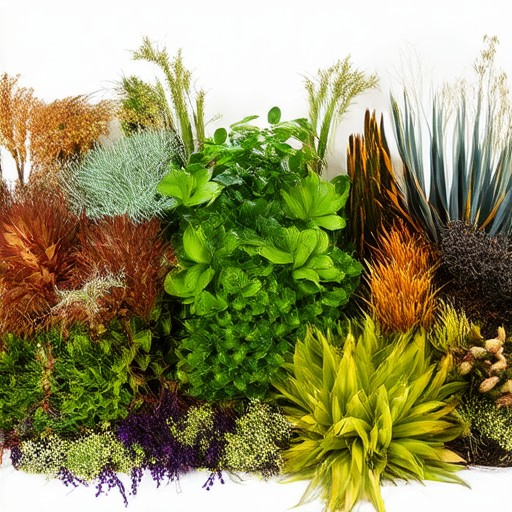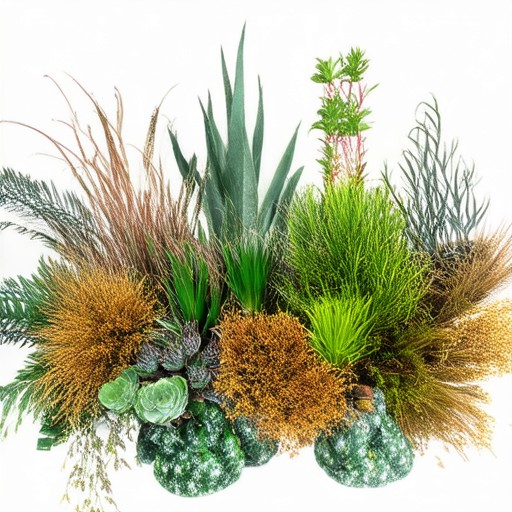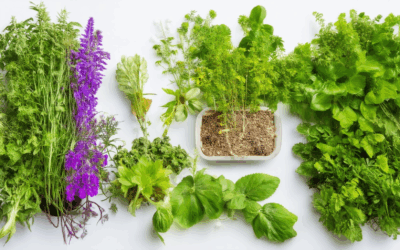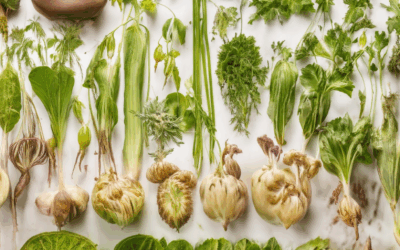As the world faces escalating challenges from climate change, the role of plants in mitigating its effects has never been more critical. Among the many strategies humanity has employed, the concept of climate-adapted heirloom plants emerges as a promising solution. These unique varieties, passed down through generations, possess remarkable resilience and adaptability, making them invaluable in combating environmental stress. Heirloom plants, known for their durability and historical significance, are now being recognized not just for their aesthetic appeal but also for their potential in contributing to carbon capture technologies. By understanding the mechanisms behind their resilience and how they thrive under varying conditions, we can unlock their full potential in fostering sustainable ecosystems. This exploration delves into the fascinating world of climate-adapted heirloom plants, examining what sets them apart and why they hold the key to a more sustainable future.
Key Takeaways
- Heirloom plants adapt to diverse climates through morphological, physiological, and behavioral traits, enabling them to thrive in various environments.
- Morphological adaptations include spines, hairs, shallow roots, and deep taproots, helping plants survive in arid and nutrient-poor conditions.
- Physiological adaptations like stomatal closure and CAM photosynthesis allow plants to conserve water in dry climates.
- Behavioral adaptations such as drought avoidance and extended herbaceous growth help plants maintain photosynthesis during lean times.
- Reproductive strategies like delayed flowering and self-pollination ensure genetic diversity and survival in challenging conditions.
- Desert plants, tropical rainforests, and alpine plants exemplify nature’s diversity in adapting to different climates.
- Real-world applications include water management systems, agricultural adaptations, flood mitigation, and urban green spaces to enhance resilience.
- Plants adapted to hot environments use thick waxy cuticles, reduced stomata, succulent tissues, reflective surfaces, and shade tolerance to manage heat and water loss.
- Heirloom carbon capture is enhanced by planting climate-adapted plants, which sequester carbon and support biodiversity, contributing to combating climate change.
What Plants Are Resilient to Climate Change?
Climate change poses significant challenges to plants, but certain species exhibit remarkable resilience due to their adaptability and evolutionary traits. These plants thrive under stressors like drought, heatwaves, and shifting temperatures.
- Sunflowers : Known for their deep root systems, sunflowers are highly resistant to drought conditions. Their ability to tolerate arid environments makes them ideal for regions experiencing water scarcity.
- Mangroves : These salt-tolerant trees thrive in coastal areas affected by rising sea levels. They stabilize shorelines and provide habitats for diverse marine life, showcasing their resilience against oceanic changes.
- Cacti and Succulents : Native to arid regions, these plants store water efficiently, allowing them to survive prolonged periods of drought. Their ability to withstand extreme heat makes them resilient to temperature fluctuations.
- Seagrasses : Found in coastal areas, seagrasses are resilient to rising sea levels and temperature increases. They play a crucial role in carbon sequestration, contributing to climate mitigation efforts.
- Alpine and High-Mountain Plants : These plants are adapted to cold climates and high elevations. As temperatures rise, they may migrate to higher altitudes, demonstrating their resilience through phenotypic adaptation.
- Herbaceous Perennials : Many perennials, such as lavender and yarrow, are known for their resilience. They can regrow from roots or stolons, making them durable in challenging conditions.
- Heirloom and Heritage Seeds : Planting seeds from heirloom varieties often ensures genetic diversity, increasing resilience to pests and environmental changes. These seeds are preserved and distributed by organizations focused on sustainable agriculture, like Old Seed .
These plants exemplify nature’s ability to adapt, offering hope for sustainable landscapes and food security in a changing world. By cultivating these resilient species, we can contribute to biodiversity conservation and climate resilience.
What Makes a Plant an Heirloom?
An heirloom plant is one that has been passed down through generations due to its unique qualities and value. These plants are cherished for their historical significance, distinctive traits, and ability to thrive in diverse conditions.
Characteristics of Heirloom Plants
- Historical Value: Heirloom plants often have a rich history, sometimes dating back centuries, making them culturally significant.
- Unique Traits: They exhibit distinct features, such as unusual colors, shapes, or flavors, setting them apart from modern varieties.
- Adaptability: Many heirloom plants are known for their resilience, thriving in various climates and soil types.
- Aesthetic Appeal: Their appearance often makes them desirable for gardens and kitchens alike.
- Culinary Interest: Some heirloom plants have unique flavors that make them sought after in cooking.
- Conservation Efforts: Preserving heirloom plants helps maintain biodiversity and ensures genetic diversity in crop populations.
Why Heirloom Plants Are Valued
- Sustainability: Heirloom plants are often more resilient, reducing reliance on synthetic chemicals and fertilizers.
- Biodiversity: They play a crucial role in maintaining ecosystem balance and supporting pollinators.
- Heritage and Tradition: Passing down heirloom plants carries cultural and historical importance, connecting us to our roots.
Growing and Preserving Heirlooms
- Heirloom plants require care and attention to nurture their unique traits.
- Preserving seeds from these plants ensures their legacy can continue for future generations.
- Visit our Gardening Tips section for more information on caring for heirloom plants.
By understanding and appreciating the special qualities of heirloom plants, we can better protect and enjoy these valuable resources for years to come.
What’s the Difference Between Heirloom and Heritage Seeds?
Heirloom and heritage seeds are closely related but have distinct origins and characteristics. Here’s a breakdown of the key differences:
- Heirloom Seeds: These seeds have been passed down through generations and are typically open-pollinated. They are known for their ability to be saved for future planting without the need for purchasing new seeds each year.
- Heritage Seeds: Similar to heirloom seeds, heritage seeds are also open-pollinated and have been preserved for decades. However, they may have a more regional focus, often developed for specific climates or soil types.
- Genetic Diversity: Both types of seeds promote genetic diversity, which is crucial for sustainable agriculture. Heirloom seeds are often recognized for their resistance to pests and diseases due to their diverse gene pool.
- Culinary Value: Heirloom seeds are prized by chefs and home gardeners for their unique flavors and textures, which are often lost in hybrid varieties.
- Adaptability: Heritage seeds may have specific traits that make them well-suited to certain regions, while heirloom seeds are generally more versatile and widely adaptable.
Both heirloom and heritage seeds play an important role in preserving biodiversity and promoting sustainable gardening practices. Whether you’re looking for unique flavors or regional adaptability, these seeds offer a valuable addition to any garden.
For more information on growing heirloom seeds, check out our guide to growing heirloom seeds . To learn about the importance of preserving heritage seeds, visit our article on heritage seed preservation .
Adaptations of Plants to the Climate
Plants have evolved remarkable adaptations to thrive in diverse environments, allowing them to survive and flourish despite challenging conditions. These adaptations can be categorized into several types, each serving a unique purpose in ensuring the plant’s survival and success.
Morphological Adaptations
Morphological adaptations are physical traits that enable plants to withstand environmental stressors. One common example is the development of spines or hairs on leaves and stems. These features act as a defense mechanism against desiccation, breaking up drying winds and reducing water loss in arid regions. For instance, cacti in desert ecosystems are covered in spines that reflect sunlight, minimizing water evaporation.
Another notable adaptation is the structure of roots. In arid climates, many plants have evolved shallow, widespread root systems to maximize water absorption from limited rainfall. Conversely, plants in nutrient-poor soils may develop deep taproots to seek out nutrients deeper below the surface.
Physiological Adaptations
Physiological adaptations involve biological processes that allow plants to function under stressful conditions. One key mechanism is ** stomatal closure , which reduces water loss through transpiration. Some plants, like succulents, store water in their tissues, enabling them to endure prolonged periods of drought. Additionally, certain plants exhibit CAM (Crassulacean Acid Metabolism)** photosynthesis, which allows them to close their stomata during the day and collect CO2 at night, conserving water in dry environments.
Behavioral Adaptations
Behavioral adaptations refer to the ways plants interact with their environment. For example, some plants exhibit drought avoidance by growing in shaded areas where humidity is higher. Others may display herbaceous growth patterns , remaining green and photosynthetic for extended periods, ensuring they can capture sunlight and sustain themselves through lean times.
Reproductive Adaptations
Reproductive adaptations ensure the survival of the species by facilitating successful pollination and seed dispersal. Many plants in arid regions delay flowering until rainfall occurs, synchronizing their reproductive cycles with available resources. Some plants rely on wind pollination, while others employ mechanisms like self-pollination or facultative parthenogenesis to ensure genetic diversity.
Examples of Plant Adaptations
- Desert Plants : Saguaro cacti in North America and saltbushes in Australia are well-known for their ability to survive in extreme aridity through spines, deep roots, and water-storing tissues.
- Tropical Rainforests : Trees in these regions often have broad, thick leaves to minimize water loss, while vines climb high into the canopy to take advantage of sunlight filtering through the forest floor.
- Alpine Plants : These plants often have small, leathery leaves and short stature to protect against cold and windy conditions, ensuring they remain viable in harsh alpine environments.
By understanding these adaptations, we gain insight into the incredible resilience and diversity of plant life, highlighting the importance of preserving habitats and supporting sustainable practices to protect these natural wonders.
Climate Adaptation Examples
Climate adaptation involves implementing strategies to reduce the impacts of climate change on ecosystems, communities, and societies. Here are some real-world examples:
- Water Management Systems: Implementing technologies like rainwater harvesting, greywater recycling, and water-efficient irrigation to manage water resources during droughts and extreme weather events.
- Agricultural Adaptations: Planting drought-resistant crops, adopting precision agriculture techniques, and establishing crop insurance programs to protect farmers against climate-related disruptions.
- Flood Mitigation Infrastructure: Building levees, wetland restoration projects, and permeable pavement to reduce flood risks in urban areas.
- Urban Green Spaces: Creating green roofs, urban gardens, and tree-planting initiatives to improve air quality, mitigate heat islands, and provide habitats for wildlife.
- Renewable Energy Integration: Expanding solar, wind, and geothermal energy systems to reduce reliance on fossil fuels and decrease greenhouse gas emissions.
- Community Education Programs: Developing awareness campaigns and training programs to help individuals and communities prepare for and respond to climate threats.
- Protected Natural Areas: Establishing nature reserves and corridors to safeguard biodiversity and provide refuge for species displaced by climate change.
- Adaptive Land Use Planning: Zoning regulations that allow for flexible land use in areas prone to wildfires, floods, or other climate events.
- Carbon Sequestration Projects: Planting forests, restoring wetlands, and implementing agricultural practices that capture and store carbon to combat global warming.
- Resilient Transportation Systems: Investing in public transit, bike lanes, and pedestrian-friendly infrastructure to reduce dependence on fossil-fuel-powered vehicles.
These examples demonstrate the importance of integrating climate adaptation strategies into daily life and governance to build resilience against climate change impacts.
How Are Plants Adapted to Hot Environments?
Plants have evolved remarkable adaptations to thrive in hot environments, enabling them to survive arid conditions and extreme temperatures. These adaptations help them conserve water, reduce heat stress, and ensure productivity despite challenging climatic conditions.
- Thick Waxy Cuticles: Many plants develop thick, waxy coatings on their leaves and stems. These coatings reduce water loss through evaporation and provide protection against intense sunlight and high temperatures.
- Reduced Stomatal Size: In hot climates, plants often have smaller stomata—the tiny pores on leaf surfaces that allow for gas exchange. Smaller stomata decrease water loss and help regulate temperature more effectively.
- Succulent Tissues: Some plants, like cacti and succulents, store water in their tissues. This allows them to go long periods without significant water intake, making them highly resilient to droughts and heatwaves.
- Reflective Surfaces: Certain plants have waxy or hairy surfaces that reflect sunlight, reducing the amount of heat absorbed. This helps prevent leaf scorching and maintains optimal leaf temperature.
- Shade Tolerance: Many desert plants have adapted to grow under shade provided by larger structures or other plants, which helps them manage temperature fluctuations and protect themselves from direct sunburn.
These adaptations allow plants to live in some of the hottest and driest environments on Earth. By minimizing water loss and managing energy efficiently, they can survive in regions where few other plants can thrive.








0 Comments